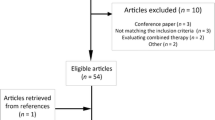Abstract
Background
Radiofrequency ablation (RFA) is an emerging minimally invasive technique for breast cancer treatment. There are two different needle designs. One is to deploy a series of arrays to allow an even distribution of heat within the tumor. A new design is a straight needle with continuous infusion of cold saline to prevent charring and ensure continuous heat delivery. We report the first comparative study using two different needles for ablation of breast cancer.
Methods
Chinese patients with breast cancer less than 2 cm were prospectively recruited. Multifocal tumor was excluded. RFA was performed under general anesthesia following sentinel node biopsy. Sequential allocation was used. In the first group, tumor was ablated by using the LeVeen needle. Cool-tip needle was used in the subsequent group. The tumor was then resected. Tumor viability was assessed by nicotinamide adenine dinucleotide-diaphorase (NADH) staining. Complete ablation rate was compared. Evidence of thermal damage to the skin was also assessed.
Results
Twenty patients were recruited. Mean tumor size was 14 mm. Complete ablation rate was the same (90% versus 89% for the Cool-tip and the LeVeen, respectively). Cool-tip has a shorter ablation time when compared with LeVeen (12 versus 28 min), and the Cool-tip needle was found to be easier to insert. There was no visible skin burn after RFA.
Conclusions
Cool-tip and LeVeen systems had the same efficacy in ablation of breast cancer, but Cool-tip was easier to insert and had a shorter ablation time.


Similar content being viewed by others
References
Hung WK, Ying M, Chan CM, Lam HS, Mak KL. Minimally invasive technology in the management of breast disease. Breast Cancer. 2009;16(1):23–9.
Simmons RM. Ablative techniques in the treatment of benign and malignant breast disease. J Am Coll Surg. 2003;197(2):334–8.
van Esser S, van den Bosch MA, van Diest PJ, Mali WT, Borel Rinkes IH, Van Hillegersberg R. Minimally invasive ablative therapies for invasive breast carcinomas: an overview of current literature. World J Surg. 2007;31(12):2284–92.
Oura S, Tamaki T, Yoshimasu T, Ohta F, Nakamura R, Okamura Y. Radiofrequency ablation therapy in patients with breast cancers two centimeters or less in size. Breast Cancer. 2007;14(1):48–54.
Goldberg SN, Gazelle GS, Solbiati L, Rittman WJ, Mueller PR. Radiofrequency tissue ablation: increased lesion diameter with a perfusion electrode. Acad Radiol. 1996;3(8):636–44.
Hung WK, Chan CM, Ying M, Chong SF, Mak KL, Yip AW. Randomized clinical trial comparing blue dye with combined dye and isotope for sentinel lymph node biopsy in breast cancer. Br J Surg. 2005;92(12):1494–7.
Izzo F, Thomas R, Delrio P, Rinaldo M, Vallone P, DeChiara A, et al. Radiofrequency ablation in patients with primary breast carcinoma: a pilot study in 26 patients. Cancer. 2001;92:2036–44.
Jeffrey SS, Birdwell RL, Ikeda DM, Daniel BL, Nowels KW, Dirbas FM, et al. Radiofrequency ablation of breast cancer: first report of an emerging technology. Arch Surg. 1999;134:1064–8.
Burak WE Jr, Agnese DM, Povoski SP, Yanssens TL, Bloon KJ, Wakely PE, et al. Radiofrequency ablation of invasive breast carcinoma followed by delayed surgical excision. Cancer. 2003;98:1369–76.
Hayashi AH, Silver SF, van der Westhuizen NG, Donald JC, Parker C, Fraser S, et al. Treatment of invasive breast carcinoma with ultrasound-guided radiofrequency ablation. Am J Surg. 2003;185:429–35.
Fornage BD, Sneige N, Ross MI, Mirza AN, Kuerer HM, Edeiken BS, et al. Small breast cancer treated with US-guided radiofrequency ablation: feasibility study. Radiology. 2004;231:215–24.
Khatri VP, McGahan JP, Ramsamooj R, Griffey S, Brock J, Cronan M, et al. A phase II trial of image-guided radiofrequency ablation of small invasive breast carcinomas: use of saline-cooled tip electrode. Ann Surg Oncol. 2007;14:1644–52.
Medina-Franco H, Soto-Germes A, Ulloa-Gomez JL, Romero-Trejo C, Uribe N, Ramirez-Alvarado CA, et al. Radiofrequency ablation of invasive breast carcinoma: a phase II trial. Ann Surg Oncol. 2008;15(6):1689–95.
Earashi M, Noguchi M, Motoyoshi A, Fujii H. Radiofrequency ablation therapy for small breast cancer followed by immediate surgical resection or delayed mammotome excision. Breast Cancer. 2007;14(1):39–47.
Susini T, Nori J, Olivieri S, Livi L, Bianchi S, Mangialavori G, et al. Radiofrequency ablation for minimally invasive treatment of breast carcinoma. A pilot study in elderly inoperable patients. Gyn Oncol. 2007;104:304–10.
Marcy PY, Magne N, Castadot P, Bailet C, Namer M. Ultrasound-guided percutaneous radiofrequency ablation in elderly breast cancer patients: preliminary institutional experience. Br J Radiol. 2007;80:267–73.
Quaranta V, Manenti G, Bolacchi F, Cossu E, Pistolese CA, Buonomo OC, et al. FEM analysis of RF breast ablation: multiprobe versus cool-tip electrode. Anticancer Res. 2007;27(2):775–84.
Kontos M, Felekouras E, Fentiman IS. Radiofrequency ablation in the treatment of primary breast cancer: no surgical redundancies yet. Int J Clin Pract. 2008;62(5):816–20.
Acknowledgments
The authors would like to thank Dr. Chi Kin Chung for his inspiration given on this work. The authors would like to acknowledge the generous support from Tung Wah Group of Hospitals’ Research Fund, Boston Scientific Hong Kong and Covidien Hong Kong.
Author information
Authors and Affiliations
Corresponding author
About this article
Cite this article
Hung, W.K., Mak, K.L., Ying, M. et al. Radiofrequency ablation of breast cancer: a comparative study of two needle designs. Breast Cancer 18, 124–128 (2011). https://doi.org/10.1007/s12282-009-0181-1
Received:
Accepted:
Published:
Issue Date:
DOI: https://doi.org/10.1007/s12282-009-0181-1




